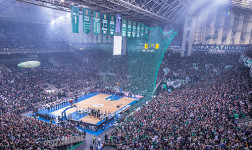By: Jacob Feldman, Harvard University
It was all going so well. The Hawaii men’s basketball team had just finished its eighth straight winning season after another year of strong attendance. But then longtime coach Riley Wallace left. And it all came apart.
After winning nearly 60 percent of its games in the three years prior to Wallace’s departure following the 2006-07 season, the Rainbow Warriors barely won a third of their games in those next three years. By the end of the 2009-10 season, the team was 10-20 and 3-13 in conference play. During that period, the number of fans in attendance dwindled from the mid-7000s to the mid-5000s.
The story of the Rainbow Warriors is a common one for mid-major teams performing above average before undergoing a coaching change. Only 22 percent of mid-majors in the second-tier (with winning percentages in the 60-80th percentile over the previous three years) improved their records during the three years after changing coaches. In terms of attendance, mid-majors in the second-tier saw dips in their three-year attendance numbers over 60 percent of the time. On average, these teams lost 342 fans per game.
Elite teams, particularly those in major conferences, faced much less adversity when bringing in a new coach.
For instance, when facing a coaching change, major-conference teams in the same second-tier (according to winning percentage) encountered an easier transition than their mid-major counterparts. Teams like Michigan, Alabama, and California all made succesful transitions thanks to the ability to bring in experienced coaches who could use their top-class facilities and national prestige while recruiting. Only a third of major-conference teams in the second-tier of winning percentage improved their records in the first three years under a new regime, but none saw their three-year winning percentage fall below 46 percent. On the other hand, 41 percent of the mid-major teams watched their team’s winning percentage fall below 46 percent. When it came to attendance, the major-conference schools were similarly stable. They gained an average of 212 fans per game in the three years after a coaching change.
Teams in the elite tier had even more success post coaching change, in terms of both attendance and winning. Schools with attendance in the 80th percentile and higher did see a general dip in fan turnout, attracting an average of 203 fewer fans per game in the three years after the change, compared to the three years beforehand. That, however, represents only a 1.7% drop instead of the 2.7 percent drop that teams in the 60th-80th percentile faced, and the 6% drop for mid-major teams in that same subset.
For teams with a winning percentage in the 80th percentile or above during the three years before a coaching change, the effect of the change on the team’s winning percentage did not depend on the team’s conference affiliation. Whether a member of a big six conference or a mid-major, elite teams won approximately 10 percent fewer games in the three year’s after a coaching change. That said, things began looking up by year three under the new leadership, as teams won an average of five percent more games compared to the previous year, jumping from 55 to 60 percent. This suggests that the coaching change wouldn’t have a long-term impact, a contrast to the changes in tier 2, where teams generally saw a downhill trend by the end of year three.
Things were completely different for teams facing a coaching change after struggling. Whereas the teams previously mentioned likely lost coaches to retirement or better-paying and higher-profile jobs, the teams transitioning after sub-par years were more likely to have fired their coach. Also, when any team hits the reset button, they trend toward the average—whether that means improving if they were bad, or declining if they were previously strong. Therefore, it makes sense that teams in the 0th-40th percentile before a change won a higher percentage of games in the three years after a coaching replacement. However, change wasn’t uniformily a cure-all, as only 56 percent of teams did improve their winning percentage. The trend of improvement wasn’t clear initially for these teams, as their winning percentages actually dipped in year one with a new coach, while teams in the 40-80th percentile saw their records improve initially before falling in years two and three. This evidence lends credibility to the assertion that year one under a new coach demonstrates more of the previous coach’s ability than the replacement’s—that there’s enough hope for the Hawaiis of the world, if not always quite enough patience.
Born just off Tobacco Road in Winston-Salem, NC, Jacob Feldman grew up in a college sports-crazed world. With the help of an intensive statistical education, he now views college sports issues with a keen eye for the mathematical factors at play.
Key Insights
We looked at coaching change and its effect on attendance evidence that year one under a new coach demonstrates more of the previous coach’s ability than the replacement’s.









